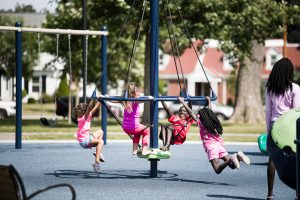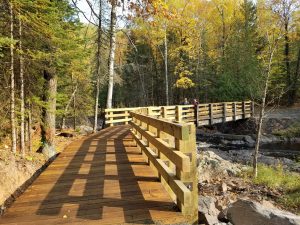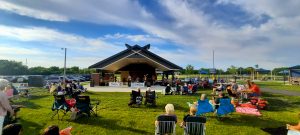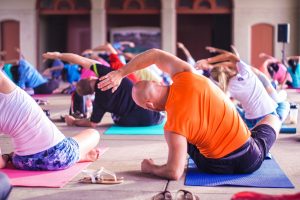This is the second article in a series focused on how the built environment influences public health. Part I provides an overview of the various places where planning and public health overlap — in transportation networks, water and waste systems, park and recreational spaces, and entrenched in conversations about land use and zoning. In Part II, we’ll take a closer look at green spaces and third places and how they promote health through recreation and socialization opportunities.
Roots of Planning for Green Spaces
Parks and green spaces are vital to the health of communities. This fact was recognized early on in planning efforts made necessary by the industrial revolution and resulting urbanization. The 20th century urban planning concept of the Garden City aimed to create self-contained communities surrounded by green spaces. It was developed by Ebenezer Howard in 1898 as a response to consequences of industrialization such as overcrowding and pollution. Examples of garden cities include Letchworth and Welwyn in England.
This work may have inspired efforts in the United States with several papers being presented at the 1900 annual meeting of the American Institute of Architects in Washington, D.C., on the topic of beautification of government buildings. This led to the appointment of a committee responsible for creating a Park Master Plan for the District of Columbia — the first of its’ kind in the U.S.
How Parks and Green Spaces Boost Public Health
In our fast-paced modern world, the importance of parks and green spaces often goes unnoticed. However, these natural havens offer more than just picturesque scenery; they have a profound impact on public health. From physical well-being to mental rejuvenation and community engagement, the benefits of parks and green spaces are far-reaching. In this article, we delve into the various ways these green sanctuaries contribute to a healthier society and explore why we should prioritize their presence in our communities.
Physical Activity and Wellness
One of the most evident advantages of parks is their capacity to facilitate physical activity. From morning jogs to family bike rides and group sports, these recreational areas offer ample opportunities to get moving. Regular exercise, as supported by countless studies, plays a pivotal role in reducing the risk of chronic diseases like obesity, diabetes, and heart conditions. Parks, therefore, act as a free, easily accessible gym for people of all ages, encouraging individuals to lead active, healthy lifestyles.

Neighborhood kids enjoying the playground at Erb Park and Pool in Appleton, WI.
Mental Health and Stress Reduction
Stress is an ever-present aspect of modern living, with adverse impacts to mental health. Luckily, parks provide an escape from the pressures of everyday life. The calming effect of nature on the mind has been scientifically validated. Spending time amidst greenery helps reduce stress, anxiety, and depression, promoting a positive outlook on life. With each visit, individuals find solace and rejuvenation in natural places, appeasing the burden of mental fatigue.

Finding solace along the Black River in Pattison State Park, WI.
Improved Air Quality and Health Equity
Green spaces are vital pieces of our environment, serving as nature’s filter to purify the air we breathe. Cleaner air reduces the risk of respiratory ailments and enhances overall respiratory health. Breathing fresh air while strolling through a park is an effective way to protect our lungs and promote better overall well-being. Moreover, parks are not exclusive playgrounds for a select few; they are democratic spaces that welcome all. Irrespective of age, socioeconomic background, or physical abilities, parks offer inclusive recreational opportunities and health benefits. Ensuring (financial and physical) accessibility of green spaces promotes health equity and ensures that everyone has an equal chance to enjoy the healing power of nature.
Social Interaction and Community Engagement
Beyond their aesthetic appeal, parks serve as melting pots for communities. They offer spaces for people to gather, socialize, and engage in various activities together. In a world where digital interactions often replace face-to-face connections, these green spaces provide opportunities to foster genuine bonds with neighbors and create a sense of belonging. This sense of community and reduced social isolation, in turn, contributes to enhanced mental well-being and overall life satisfaction.

Enjoying community music and entertainment at Bakken Park in Cottage Grove, WI.
Enhanced Cognitive Function and Sleep Patterns
Exposure to nature has a profound impact on cognitive function. Studies have revealed that spending time in natural environments enhances attention, focus, and creative thinking. Regular visits to parks allow the mind to recharge, reducing mental fatigue and boosting productivity. Moreover, the benefits of parks even extend to our nighttime routine. People who spend time in nature and engage in physical activity during the day tend to experience improved sleep patterns and better overall sleep quality. The connection between nature and sleep is yet another reason to embrace the parks’ therapeutic potential.
Third Places
Third places is a sociological term defined by Ray Oldenburg in his 1989 book The Great Good Place. The term is used to describe the places where people spend time outside of their home (first place) and work (second place). Places that serve this purpose tend to be where people can connect easily and regularly such as parks, community centers, coffee shops, hair solons/barbers, gyms and even some more casual restaurants. Third places play an important role in developing and sustaining a strong sense of community and providing opportunities for socialization which is critical to mental health.

In recent history, American society has gone away from spending time in third places. In Bowling Alone: The Collapse and Revival of American Community, Rober D. Putnam describes the decline of social capital in the United States since the 1950s. He highlights the reduction of social interaction pointing to the loss in membership and volunteerism in organizations such as religious groups, labor unions, parent-teacher associations, Federation of Women’s Clubs, League of Women Voters, military veterans’ organizations, Boy Scouts, the Red Cross, and fraternal organizations such as Lions Clubs, Rotary, and Kiwanis. The title of the book is derived from Putnam’s observation that while the number of people who bowled in the U.S. has increased in the last couple of decades, the number of people bowling in a social league environment has decreased.
The big questions are: what is the cause of this trend and how can we counteract it? Oldenburg pointed to “unfunctional zoning” that limits commercial development in residential areas, and promotes car-centric, suburban development that favors big box, chain stores and strip malls over local business. Many people can go a full day without interacting with another person outside of their home and work by the simple fact that they commute in a personal vehicle parked in their garage.

One strategy is for communities to foster development of third places is by ensuring zoning regulations allow for mixed-use functions. Allowing people to live, work, and play in proximity creates more opportunities to enjoy third spaces. This can be further enhanced by connecting these places through active transportation options such as sidewalks and bike lanes, as well as allowing for transit stops near these locations.
Ultimately, third places promote a stronger sense of community which begets better quality social interaction and improved mental well-being. Communities play an important role in creating opportunities for those places to thrive.
Parks, green spaces, and third places stand as pillars of public health, elevating physical, mental, and social well-being in a multitude of ways. Their role as promoters of physical activity, stress relief, social interaction, and cognitive rejuvenation makes them indispensable to a healthier society. As we strive for better health outcomes and improved quality of life, we must prioritize the creation and preservation of these public sanctuaries.
In Part III of our “Intersections of Health & the Built Environment” series, we’ll underscore the importance of making informed, evidence-based policy decisions in land use, zoning, and transportation systems to positively influence citizen health.
